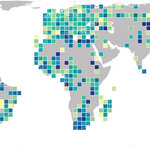Genetics & Molecular Biology

Pop culture is in a bit of a quandary. Though food is essential for life, culturally it is no longer a basic necessity, and that's thanks to science. We grow more food on less land than ever dreamed possible. Even Europe, with all its political limitations in agriculture. Food is a cheap commodity and that makes it a values issue.
Being able to afford to eat meat every day was once a dream for poor people but now it's so common an entire $2 billion environmentalism industry claims meat is killing the planet, despite livestock being a relative pittance in emissions. Given that, you'd…

When most people think of rubber, they usually just think of tires but natural rubber is an incredibly important yet under-appreciated bioresource used to make at least 50,000 different products.
Approximately 13 million tons are collected every year from tapping 39 billion liters of latex (by hand!) from rubber trees, mostly in southeast Asia - enough to fill over 5,200 Olympic-sized swimming pools. After collection, 11% of the latex is centrifuged to remove half of the water, and the rest is converted to solid rubber. The concentrated latex is shipped to manufacturers of articles,…

The conjugative transfer of anti-antibiotic resistance genetic elements could lead to development of probiotic bacteria that re-sensitize resistant bacteria to antibiotics, providing a solution to a crucial problem - how to get new antibiotics when countries cap what companies can charge for medicine, meaning they might never be profitable.
Bacteria become resistant due to the use of antibiotics and the exchange of resistance genes between bacteria.
“Because of gene exchange, bacteria can develop resistance even if they are not exposed to antibiotics. Especially among notorious hospital…

https://www.grain.org/bulletin_board/entries/5843-farmer-groups-hit-phil...
MASIPAG is a nework of farmers’ groups, scientist and non-government organizations in the Philippines seeking to improve the farmers’ quality of life through their control over genetic resources, agricultural technology and associated knowledge.
https://www.grain.org/bulletin_board/entries/5843-farmer-groups-hit-phil...
MASIPAG is a nework of farmers’ groups, scientist and non-government organizations in the Philippines seeking to improve the farmers’ quality of life through their control over genetic…

The Rainbow Papaya in Hawaii is a great example of how biology solved a devastating problem that nature created and chemicals could not fix. It put GMOs, the successor to mutagenesis, on the map worldwide, and today billions of meals have been served using GMO science.
Now a papaya (Carica papaya) may give sugar a boost also. As it ripens its cell walls separate, making the tissue softer so the cell contents become more accessible and the sucrose in the fruit is more easily extracted. Sugarcane roots undergo a similar process. Their cell walls are modified during development to form gas…

A Massachusetts-based company earlier this month cleared the last regulatory hurdle from the Food and Drug Administration to sell genetically engineered salmon in the U.S. Animal genomics expert Alison Van Eenennaam, who served on an advisory committee to the FDA to evaluate the AquAdvantage salmon, explains the significance of the FDA’s move and why some have criticized its decision.
1. How is AquaBounty’s salmon different from a conventional salmon?
The main difference is that AquaBounty’s AquAdvantage salmon grows faster than conventional salmon, and therefore gets to market weight in…

Do you prefer to rise early with the lark or stay up late with the owl? Your preference turns out to be partly decided by your genes. Our genetic study of nearly 700,000 people has revealed new insights about the genetics of chronotype – our preference to rise early or sleep late – and how it influences our mental and physical health.
We all lie somewhere on the chronotype bell-curve, with larks (early sleepers) at one end and owls (late sleepers) at the other. Our chronotype is partly influenced by our environment. Factors include season, latitude and whether we live in an urban area. Men…

Though mitochondria, the energy factories of our cells, are the root of numerous diseases, including thousands in children each year, funding for such diseases is scant compared to heart or breast cancers or other medical issues.
That may be because it is hard to understand. But progress is being made. A group of researchers from the Andalusian Centre for Molecular Biology and Regenerative Medicine (CABIMER) has revealed new ways to understand the molecular basis of some human diseases that are stem from poor functioning of the mitochondria and, in this way, allow for the development of…

Whenever we talk about people and how they behave on a certain environment there seems to be a general consensus in the way it should be. Society summarizes the sum of individuals, and bring with it a single framework from which every person can work from there to face reality. Some of those products are education, laws and morality just to name a few.
As we can see there has been certain level of success by acknowledging the social construct. Why hasn’t it been completely successful? There’s an underlying assumption we have complete control over the way we think.
When we enter the realm of…

In 8,000 B.C., when there were only about 10 million people on the entire planet, the boom and bust of famine and feast and wondering when the next meal would be was already a cultural concern.
And so agriculture was created. Mankind set out to do genetic engineering, doing RNA Interference (RNAi) cereals, legumes, roots and tubers. They not only scientifically selected for larger fruits, uniform ripening and taste, they even turned dangerous natural foods into healthy ones.
8,000 BC? Isn't RNAi new, the successor to GMOs? No, the precision of modern RNAi is new, it won the Nobel…